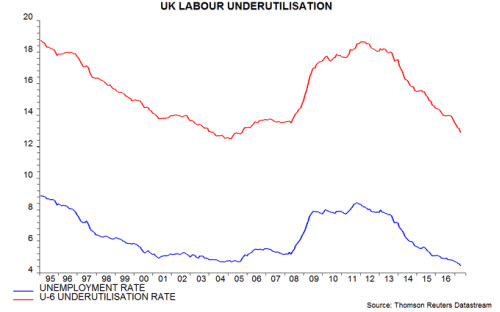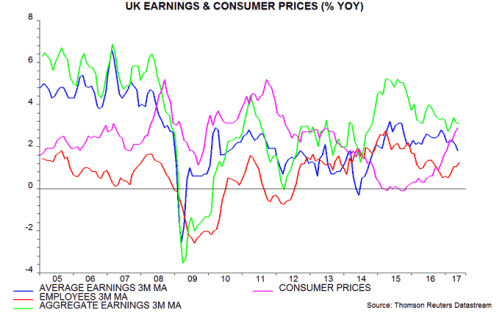
Janus Henderson: UK labour market strength adds to pressure on MPC
The UK labour market tightened further last quarter, consistent with the view here that the economy has retained momentum and strengthening the case for a “pre-emptive” rise in interest rates, despite continued subdued pay growth.
17.07.2017 | 10:01 Uhr
The unemployment rate fell to 4.5% over March-May, below the MPC’s forecast of 4.7% for the second quarter in the May Inflation Report and the lowest since 1975. The single-month estimate for May was 4.4%.
The unemployment rate understated labour market slack earlier in the upswing, because there were unusually large numbers of people either working part-time involuntarily or not actively seeking employment, despite wanting a job. This “hidden” margin has eroded rapidly since 2014. A broader measure* of labour underutilisation (i.e. a UK equivalent of the US U-6 rate) fell further to 12.9% over March-May, close to a 2005 low of 12.5% in the last economic upswing – see first chart. The gap between the underutilisation and unemployment rates is the smallest since 2008.

Annual growth of average weekly earnings, including bonuses, weakened further to 1.8% over March-May, the lowest since 2014. Regular earnings growth, however, ticked up to 2.0%. Private-sector regular growth was 2.2% over March-May and 2.4% in May alone, a five-month high.
While overall pay trends remain subdued, the MPC’s assessment will also take into account recent weaker-than-expected productivity performance, faster growth of non-wage labour costs and a possible lifting of the 1% cap on public-sector pay increases.
Annual growth in aggregate weekly earnings (i.e. average earnings multiplied by the number of employees) was unchanged at 3.1% over March-May, supported by a further rise in employment expansion to 1.3%, a 10-month high – second chart. Aggregate earnings, therefore, are currently still just outpacing consumer prices – a contrast with the last inflation upsurge over 2009-11, when earnings lagged significantly.

*Total unemployed plus number working part-time because could not find full-time job plus number inactive but wanting a job, expressed as % of labour force plus number inactive but wanting a job.



Diesen Beitrag teilen: